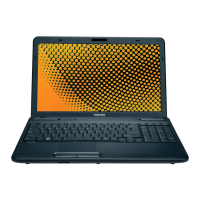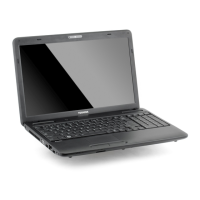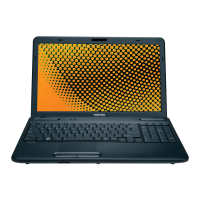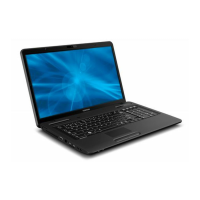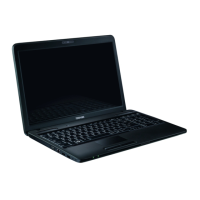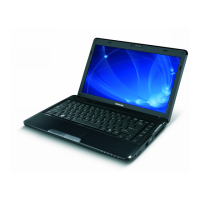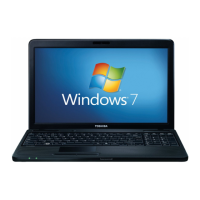
Do you have a question about the Toshiba Satellite C655 and is the answer not in the manual?
| Display Size | 15.6 inches |
|---|---|
| Resolution | 1366 x 768 pixels |
| Optical Drive | DVD SuperMulti drive |
| Wireless | Wi-Fi 802.11b/g/n |
| LAN | 10/100 Ethernet |
| USB Ports | 2 x USB 2.0 |
| Battery | 6-cell Lithium-Ion |
| RAM | Up to 8GB DDR3 |
| Graphics | Intel HD Graphics |
| Operating System | Windows 7 Home Premium |
| Weight | 5.5 lbs |
| Webcam | Built-in webcam |
| Ports | VGA |
| Processor | Intel Pentium or Celeron |
| Dimensions | 15.0 x 9.8 x 1.5 inches (approximate) |
Explains manual formatting, abbreviations, icons, keys, messages, and terminology used.
Details precautions for ventilation, environment, and personal safety to prevent injury.
Covers equipment checklist, software, connecting power, opening display, and powering on/off.
Explains how to create and restore recovery media and system recovery options.
Identifies ports, slots, buttons, and indicators on the computer's exterior.
Explains the function of various system and keyboard status lights.
Details using the Touch Pad, Web Camera, optical drives, and media care.
Explains software utilities like Face Recognition, disc writing, video player, sound, and network connections.
Provides guidelines for cleaning, moving, and managing computer heat.
Explains CPU, Memory, Power, Disks, Display, Sound, Multimedia, and Communication hardware.
Covers utilities like HW Setup, Power Saver, and special features including power management.
Describes optional devices, memory slots, card handling, and additional memory modules.
Covers typewriter keys, function keys, hot keys, and FN key combinations for system control.
Explains power conditions, indicators, battery types, charging, monitoring, and maximizing battery life.
Details Sleep/Hibernation modes, password security, and panel power control.
Covers accessing and using the HW Setup utility for various system configurations.
Covers troubleshooting processes, checklists, and solutions for various hardware and software problems.
Details physical dimensions, environmental requirements, power, and external port pin assignments.
Details the display controller's role and video mode configuration via screen resolution settings.
Details Wireless LAN, Bluetooth, safety cautions, and radio regulatory compliance.
Details power cord requirements and outlines certification agencies for global compliance.
Explains factors affecting CPU, memory, battery, HDD, LCD, GPU, Wireless LAN performance, and copy protection.
Lists and defines technical terms and abbreviations found in the manual.
An alphabetical listing of all topics covered in the manual for easy navigation.
